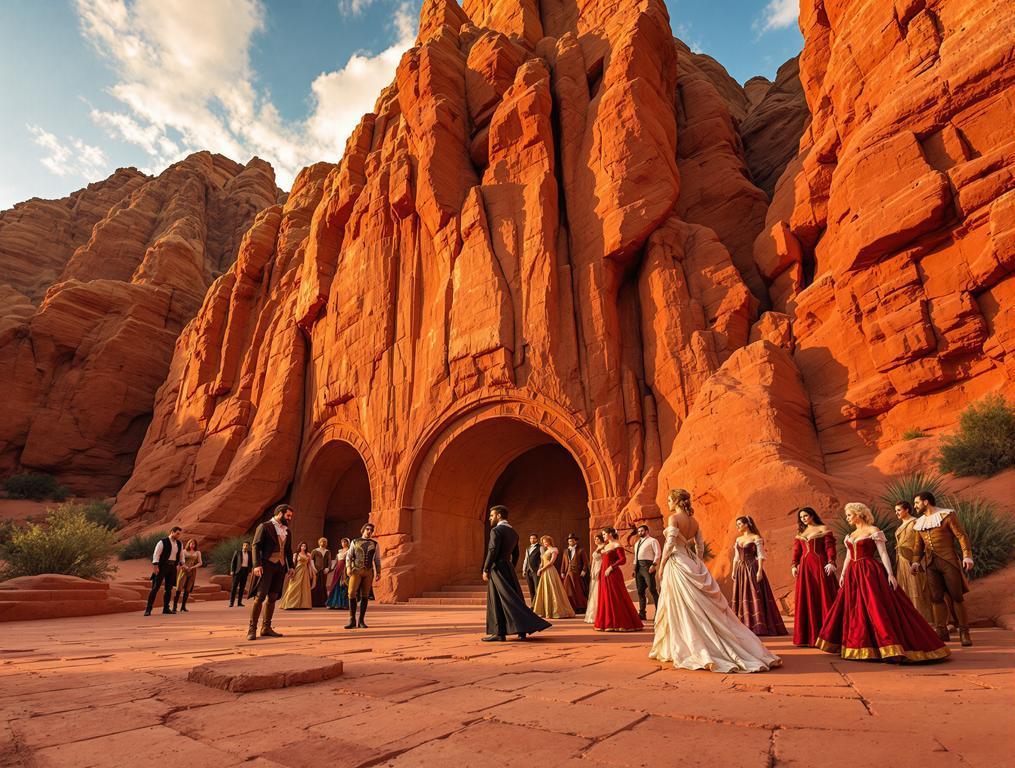I’m standing at the edge of a red rock amphitheater where bearded men in tights are rehearsing sword fights while women in period costumes adjust their corsets nearby. This isn’t a Renaissance faire – it’s a Tuesday morning in Cedar City, Utah, elevation 5,800 feet, where I’ve stumbled upon a rehearsal for this evening’s performance of Macbeth. The contrast is surreal: Elizabethan drama against a backdrop of rust-colored cliffs that would make any Western film director salivate.
What’s even more surprising is the scale. Cedar City has just 42,923 residents in 2025, yet the Utah Shakespeare Festival draws over 100,000 visitors annually. That’s a staggering 2.3:1 visitor-to-resident ratio – the kind of cultural pilgrimage numbers you’d expect in Ashland, Oregon, not a former iron mining town in southern Utah.
Where Shakespeare Meets Red Rock: Utah’s Unlikely Cultural Phenomenon
A decade ago, Cedar City was primarily known as a pit stop between Las Vegas and Salt Lake City. Today, it’s emerging as America’s newest cultural hub. The transformation reminds me of how Ashland evolved from timber town to theater destination, but with a uniquely Western twist.
“You can watch ‘A Midsummer Night’s Dream’ in the afternoon and be standing at Cedar Breaks National Monument for sunset – from iambic pentameter to 10,000-foot views in under an hour. Try finding that combo in England,” a festival regular tells me while waiting in line for tickets.
This blend is by design, not accident. The Utah Shakespeare Festival, launched in 1962, has grown into one of America’s premier theater events, earning a Tony Award for Outstanding Regional Theatre. The outdoor Adams Shakespearean Theatre is modeled after the bard’s own Globe Theatre, creating an authentic experience at one-third the cost of flying to London.
What distinguishes Cedar City’s festival from Oregon’s Shakespeare destination that draws theater enthusiasts is the stunning natural backdrop. While Ashland has its charm, it can’t compete with Cedar City’s proximity to five national parks within a two-hour drive.
America’s Tuscany: Culture and Natural Wonders at 5,800 Feet
Cedar City’s elevation provides cool relief from summer heat. At 5,800 feet, temperatures typically run 15-20 degrees cooler than St. George or Las Vegas, similar to Montana’s high-elevation mountain town that attracts heat-escaping tourists.
The dramatic landscapes surrounding the city create a setting reminiscent of volcanic islands sitting 7,000 feet above the clouds. Cedar Breaks National Monument’s amphitheater of eroded red rock formations creates a natural companion to the theatrical performances downtown.
“We came for Hamlet but stayed for the hiking. There’s something magical about discussing Shakespeare’s soliloquies while watching the sun set over red rock formations that have stood for millions of years. It’s like the plays gain new meaning out here in the Western landscape.”
Like other gateway towns channeling millions of national park visitors, Cedar City leverages its location as a base for exploring Zion, Bryce Canyon, and Cedar Breaks. But unlike crowded Springdale near Zion, Cedar City retains its authentic character.
Summer 2025 Prediction: Cedar City’s Emergence as the West’s Cultural Hub
Cedar City is experiencing a 21% population growth since 2020, signaling its emergence as Utah’s cultural capital. This growth parallels what Sedona experienced in the 1990s – a transformation from quiet town to destination.
The Shakespeare Festival represents economic revitalization in rural America, creating hundreds of seasonal jobs. With festival tickets ranging from $20-75, it remains accessible compared to Broadway’s $200+ prices.
For optimal festival experience, book accommodations at least 30 days in advance. Plan to attend performances on Tuesday or Wednesday evenings when crowds are smallest. Pro tip: the free Green Show before each evening performance offers Renaissance music and dancing without a ticket.
As I watch the rehearsal wrap up, I’m struck by the improbability of it all – world-class Shakespeare in the shadow of red rock country. The air is crisp at this elevation, the sunlight intense. My daughter Emma would love the costumes, while my wife Sarah would be photographing the incredible juxtaposition of performers against those rust-colored cliffs.
Cedar City feels like America’s answer to those European hilltowns where culture and landscape exist in perfect harmony. In a country where we often separate our cultural destinations from our natural ones, Cedar City’s fusion feels like the future of American travel – no passport required.
